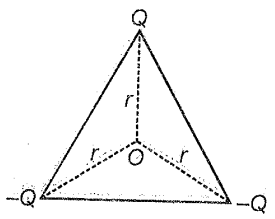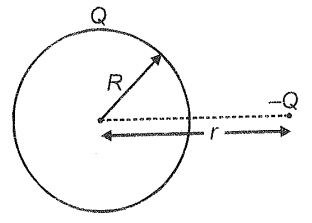At the three corners of an equilateral triangle, charges are placed as shown in the figure. The magnitude of the electric field at point O is

1.
2.
3.
4.

Two symmetrical parallel metal each of one side plate area A having charges are placed at small separation. What will be the electric field at a point in between the plates?
1.
2.
3.
4.
An electric dipole of the moment is released in a uniform electric field from the position of maximum torque. The angular speed of the dipole when becomes parallel to will be [l = moment of inertia of dipole]
1.
2.
3.
4.
A charge Q is given to a conducting sphere of radius R. Now if a charge -Q is placed, as shown, at a distance r from the center, then the magnitude of the force of attraction between charges is

1.
2. <
3. >
4.
If the electric flux entering and leaving a closed surface are respectively of magnitude , then the electric charge inside the surface will be
1.
2.
3.
4.
Electric field at an axial point of short dipole is . If the electric field at the equatorial point of same dipole is , then which of the following is correct?
1. . < 0
2. . > 0
3. . = 0
4. . =
A long thin rod is charged such that charge per unit length of the rod is . The rod is inserted into a hollow spherical surface of radius R. Maximum electric flux coming out the surface is
1.
2.
3.
4.
Two charges q and 4q are separated by a distance r. The neutral point(in between the line joining the charges) is at a distance:
1.
2.
3.
4.
A positron and a proton are projected normally into a uniform electric field with equal kinetic energy. The trajectory followed by them are:
| 1. | Circular with equal radius |
| 2. | Elliptical with the same major and minor axis |
| 3. | Parabolic with the identical trajectory |
| 4. | Hyperbolic with the identical trajectory |
The distance between two point charges is increased by 10%. The force of interaction
1. Increases by 10%
2. Decreases by 10%
3. Decreases by 17%
4. Increases by 17%






